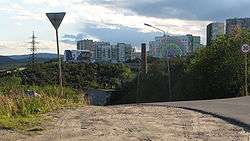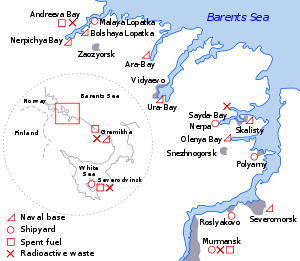Snezhnogorsk, Murmansk Oblast
| Snezhnogorsk (English) Снежногорск (Russian) | |
|---|---|
| - Town[1] - | |
 The Rainbow House in Snezhnogorsk | |
.svg.png) Location of Murmansk Oblast in Russia | |
 Snezhnogorsk | |
|
| |
_(1992).png) |
|
|
| |
| Administrative status (as of December 2013) | |
| Country | Russia |
| Federal subject | Murmansk Oblast[1] |
| Administratively subordinated to | closed administrative-territorial formation of Alexandrovsk[1] |
| Municipal status (as of June 2013) | |
| Urban okrug | Alexandrovsk Urban Okrug[2] |
| Statistics | |
| Population (2010 Census) | 12,683 inhabitants[3] |
| Time zone | MSK (UTC+03:00)[4] |
| Founded | 1970 |
| Town status since | 1980 |
| Previous names |
Murmansk-60, Vyuzhny |
| Postal code(s)[5] | 184682, 184683 |
| Dialing code(s) | +7 81530 |
| Snezhnogorsk on Wikimedia Commons | |
Snezhnogorsk (Russian: Снежного́рск) is a town under the administrative jurisdiction of the closed administrative-territorial formation of Alexandrovsk in Murmansk Oblast, Russia. Population: 12,683 (2010 Census);[3] 12,737 (2002 Census).[6]
History
It was founded in 1970 and was granted town status in 1980. It was previously known as Murmansk-60 and Vyuzhny.
Administrative and municipal status
Within the framework of administrative divisions, Snezhnogorsk is subordinated to the closed administrative-territorial formation of Alexandrovsk—an administrative unit with the status equal to that of the districts.[1] Within the framework of municipal divisions, the town of Snezhnogorsk is a part of Alexandrovsk Urban Okrug.[2]
Economy

The town's main employer is the Nerpa shipyard, which services and repairs the nuclear submarines of the Russian Northern Fleet.
References
Notes
- 1 2 3 4 Registry of the Administrative-Territorial Structure of Murmansk Oblast
- 1 2 Law #530-01-ZMO
- 1 2 Russian Federal State Statistics Service (2011). "Всероссийская перепись населения 2010 года. Том 1" [2010 All-Russian Population Census, vol. 1]. Всероссийская перепись населения 2010 года (2010 All-Russia Population Census) (in Russian). Federal State Statistics Service. Retrieved June 29, 2012.
- ↑ Правительство Российской Федерации. Федеральный закон №107-ФЗ от 3 июня 2011 г. «Об исчислении времени», в ред. Федерального закона №271-ФЗ от 03 июля 2016 г. «О внесении изменений в Федеральный закон "Об исчислении времени"». Вступил в силу по истечении шестидесяти дней после дня официального опубликования (6 августа 2011 г.). Опубликован: "Российская газета", №120, 6 июня 2011 г. (Government of the Russian Federation. Federal Law #107-FZ of June 31, 2011 On Calculating Time, as amended by the Federal Law #271-FZ of July 03, 2016 On Amending Federal Law "On Calculating Time". Effective as of after sixty days following the day of the official publication.).
- ↑ Почта России. Информационно-вычислительный центр ОАСУ РПО. (Russian Post). Поиск объектов почтовой связи (Postal Objects Search) (Russian)
- ↑ Russian Federal State Statistics Service (May 21, 2004). "Численность населения России, субъектов Российской Федерации в составе федеральных округов, районов, городских поселений, сельских населённых пунктов – районных центров и сельских населённых пунктов с населением 3 тысячи и более человек" [Population of Russia, Its Federal Districts, Federal Subjects, Districts, Urban Localities, Rural Localities—Administrative Centers, and Rural Localities with Population of Over 3,000] (XLS). Всероссийская перепись населения 2002 года [All-Russia Population Census of 2002] (in Russian). Retrieved August 9, 2014.
Sources
- Official website of Murmansk Oblast. Registry of the Administrative-Territorial Structure of Murmansk Oblast (Russian)
- Мурманская областная Дума. Закон №530-01-ЗМО от 2 декабря 2004 г. «О наделении статусом городского округа закрытых административно-территориальных образований Мурманской области», в ред. Закона №1812-01-ЗМО от 19 декабря 2014 г. «Об упразднении населённого пункта Мурманской области и о внесении изменений в отдельные законодательные акты Мурманской области». Вступил в силу 1 января 2005 г. Опубликован: "Мурманский Вестник", №234, стр. 3, 7 декабря 2004 г. (Murmansk Oblast Duma. Law #530-01-ZMO of December 2, 2004 On Granting Urban Okrug Status to the Closed Administrative-Territorial Formations of Murmansk Oblast, as amended by the Law #1812-01-ZMO of December 19, 2014 On Abolishing an Inhabited Locality in Murmansk Oblast and on Amending Various Legislative Acts of Murmansk Oblast. Effective as of January 1, 2005.).
External links
- Unofficial website of Snezhnogorsk (Russian)
